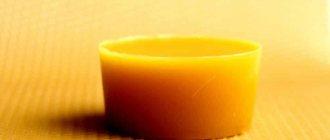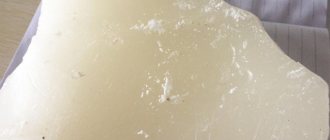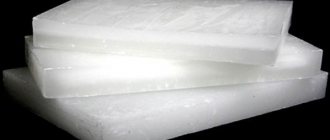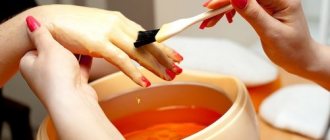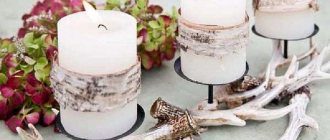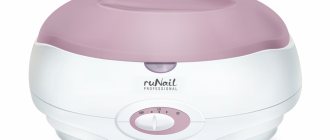How to make wax candles at home?
Cut the lemon into halves and remove the pulp. Half a lemon will become a mold and at the same time a candlestick. Melt the wax in a water bath, add food coloring and lavender flowers to it, stir. Place a wick in the center of the lemon half and fill it with melted wax.
Interesting materials:
Why don't I have sound on YouTube? Why do some tropical plants have no growth rings? Why do orchid leaves disappear? Why does the eagle have two heads? Why do bees have hexagonal honeycombs? Why do processors have different sockets? Why does my child have dry skin? Why does a St. Bernard have a barrel? Why doesn't Yota have a network? Why does the lighter have no spark?
General rules and recommendations for burning wax
To melt sushi and the finished product, enamel, aluminum, wooden or pottery glazed dishes and stainless steel containers are usually used. Before firing, the raw materials must be crushed and cleaned. It must be melted without overheating or boiling, with regular stirring.
Help! Fatty acids contained in large quantities in the composition of wax, when it reaches the melting point, react with metals, forming emulsifying salts. The quality of the wax is greatly reduced. Therefore, for heating sushi, do not use dishes made of cast iron, copper, zinc, iron, or even tinned ones.
By the way, we have already written in detail about beeswax here.
Wax melting point
At 30-35°C natural wax is in a solid state. Heated to 35-47°C, it becomes plastic, and from this moment the plasticity begins to increase rapidly until the wax begins to melt at 60-65°C.
At 95-100°C it bubbles, becoming foamy if it contains an emulsion. Thus, emulsified wax decomposes into pure product and water. As soon as the water evaporates, the bubbling stops. At a temperature of 250-300°C it begins to smoke and then ignites.
Types of paraffin
Depending on the melting point, paraffins are divided into liquid, solid and microcrystalline. According to the degree of purification, they are divided into purified and unrefined. The former contain a large percentage of oil (up to 30% by weight), while the unrefined ones contain only 6%. The color of paraffin indicates the degree of its purification. White is refined, and yellow or brown is unrefined.
There are many ways to use paraffin at home: treatment and warming with it, cosmetic procedures, making candles and various other creative items. To carry out cosmetic procedures at home, you need to know how to melt paraffin at home.
How to melt wax with a wax melter
In beauty salons, wax is heated using a special electrical device - a wax melter. By design, such devices come in cans and cassettes. Wax melters of the first type are capable of heating a large volume of wax or paraffin at one time. This takes them 15-20 minutes.
Devices of the second type are designed for heating wax in cartridges. Cassette wax melters, in turn, come with or without a stand. The former melt the wax in 20-25 minutes, the latter - in 30-40 minutes.
Advantages of working with a wax melter:
- The compact device takes up little space and can be taken on the go.
- It consumes minimal energy and is safe to use.
- The wax in the device quickly heats up to the set temperature.
- Thanks to the thermostat, the heated hot product does not freeze.
Using the wax melter is convenient and simple. Since it is inexpensive, it can be purchased for home waxing procedures. Undoubtedly, it will also be useful for craftswomen who are interested in making candles. If you have to use hot wax from time to time, it is better to use other heating methods.
Melting with water
Here's what else you can use to melt the substance at home. This is a fairly simple method, but you will have to tinker with the resulting raw materials in order to collect it from the surface of the water.
Take a fairly deep aluminum saucepan and cut the bee products into small pieces. Water pours out from above. But you need to take exclusively spring or melted water. In extreme cases, a high-quality filtered one will do. If you use tap water or it is hard, the resulting component will have a grainy structure and crumble.
Then the saucepan along with water and bee product is placed on low heat and kept until the substance becomes liquid. At the same time, it all floats to the surface of the water.
This process takes about 30 minutes. After which you need to remove the pan from the heat and allow the clean component to rise to the surface of the water. After which it is carefully collected.
Common Mistakes
Sometimes the following mistakes are made:
- I don’t keep it in a heated state for long enough, which leads to incomplete melting of the substance.
- When using wax melters, you need to know exactly which one is suitable for processing. It can be diluted in turpentine, hydrogen sulfide, gasoline, alcohol, and chloroform. These substances are good solvents. But to dilute with alcohol, you cannot bring it to a boil. But in this method it is important to be careful and accurate.
Several ways to melt paraffin
It is worth understanding that paraffin left over from burnt candles is not suitable for cosmetic procedures. For this purpose, special cosmetic paraffin is used. It can be purchased at pharmacies or specialty stores. Do you know how to melt paraffin? The easiest way is a water bath. To do this, you will need two metal containers of different diameters, water for heating and a thermometer. Stages:
- Pour about a third of water into a larger diameter container and boil it on the stove.
- Chop the paraffin into small pieces. It is most convenient to do this on newspaper or large format paper. When cutting, the paraffin will crumble. To do everything carefully and not lose the valuable substance, the litter will come in handy.
- Place the finely chopped paraffin in a container of smaller diameter and shake off the crumbs from the newspaper there.
- After the water boils, measure its temperature with a thermometer; it should show no more than 55 - 80 °C. At higher temperatures, the paraffin will begin to evaporate.
- Reduce the gas and place a smaller container on top of the boiling water so that its bottom touches the water.
- Stir the paraffin with a metal spoon until it completely melts.
- When melting, the volume of the substance in the container will decrease. If it is not enough, you can add a few more pieces to the already melted paraffin.
Make sure the container is completely dry before melting the paraffin. Water ingress into liquid paraffin is strictly prohibited. When it comes into contact with water, the hot mass will shoot and splash, and contact with the skin may cause a burn.
Contraindications
Procedures with hot paraffin are not recommended in the following cases:
- for open wounds on the skin of the hands and face;
- purulent inflammation;
- fungal diseases and eczema;
- diabetes;
- vascular diseases;
- asthma.
The beneficial qualities of paraffin do not end there. It is often used for home heating for bronchitis and common colds. Here it is also important to use a special cosmetic substance, which can be purchased in pharmacies or specialty stores.
Rules and temperature
Bees use wax to make honeycombs, in which they then store honey products and raise larvae.
People began to use this substance for different purposes, so you need to know exactly how to melt wax at home:
- At a temperature of +35°C it still remains in a solid state.
- When the temperature begins to rise above the specified level, the substance begins to melt, but it does so gradually. At first it simply becomes more plastic, and only then, with a further increase in performance, does it turn into a liquid state.
- Depending on the composition (it may not fluctuate significantly) and, most importantly, the method of obtaining the final raw material, the average melting temperature of wax ranges from +69°C to +72°C.
- It is important to consider that it is the component that the bees themselves made that is the most refractory and turns into a liquid state when heated above +72°C.
- It is also necessary to take into account that at temperatures above +95°C, due to the presence of impurities, the liquid component begins to foam. This is due to water, which, when heated this way, begins to boil and form foam. Therefore, if the wax needs to be boiled, you must not move away from the pan, otherwise the component will simply begin to “run away.”
- But, with further heating, the water evaporates and the formation of foam stops. But, this is only if the water is not in the form of emulsified impurities, alkaline or soapy components.
After it becomes clear at what temperature parameters at home it is possible to convert the solid state of a substance into a liquid state during heating, you need to consider how to properly heat and melt the wax and what methods to use for this. Also, in some cases you need to know exactly how to clean it after this procedure.
The effect of paraffin therapy
The described hand baths and face masks have a complex therapeutic effect on the skin and joints. Paraffin therapy is recommended in the presence of peeling and microcracks on the skin, pigmentation, frostbite, arthritis and arthrosis. This procedure also has a targeted restorative effect on the nail plate; if the nails are peeling or often break, paraffin therapy is perfect for restoring their structure.
The easiest way to melt wax in an apiary
The simplest method of melting wax is suitable for small apiaries. This means that a novice beekeeper needs to master this technique. It is not always affordable to buy a wax melter in a store or order it online.
And there is no need to buy it if you have several bee colonies. Because purchasing it is an additional expense. And they are very large if the beekeeper starts an apiary from scratch. Therefore, such beekeepers must master this technique.
I used the simplest method of melting wax for a very long time, about eight years.
Over time, I collected more stock of half-frames for stores. They also need to be discarded over time.
I like the simplest method of melting wax because of its simplicity.
Because the beekeeper can melt wax raw materials at any time of the year and in any weather.
A barn with a stove or a summer kitchen is suitable for this.
To apply this technique in an apiary, you first need to prepare wax raw materials.
If these are pieces of honeycombs, tongues, or wax scraps (zabrus), then they are ready to be melted into wax.
But the wax raw material from the frames or half-frames must be cut with a knife, after cutting the wire with wire cutters.
If you have good quality wire, then leave it for reuse.
Next, take a large container. I have a saucepan for 4 buckets of water. And pour a bucket of water (10 liters) into the pan.
We put it on the stove and keep the fire going. Throw the wax raw material into a pan of water.
I threw raw materials from 15 frames or 30 half-frames. You can add more raw materials, but it is not advisable, since when boiling, this whole mass rises (like milk) and there is a possibility that the wax will run off onto the stove.
While the water is boiling and the wax is melting, you need to prepare a second container.
I also have a saucepan, but for 20 liters. This pan must be tied with several layers of gauze or old burlap, which will be more reliable.
Next, when the water boils, the wax melts. At this time, you should not leave the stove, as the wax may escape.
When the boiling water has melted all the wax raw materials, remove the large pan from the heat and pour the raw materials into a smaller pan.
Then carefully take gauze or burlap by the edge. Connect both edges, forming a knot, which is secured with wire or rope.
The work must be done carefully so as not to get burned.
We hang the bundle of merva over the pan so that the remaining wax runs off.
If wax is heated in cold weather, then the room temperature should be at least 15 degrees, because too much wax will remain in the merv.
Next, the remaining wax flows into the pan until the merva hardens.
Then take the pan and put it in a warm place. They wrap it with old sweatshirts or other rags.
It is necessary to remember that the cooling time of the wax in the pan directly affects its quality.
Its quality is also affected by the purity of the water. Therefore, it is necessary to use soft water, preferably rainwater.
And the next day a wax ingot had already formed in the pan. It is removed from the pan, turned over and cleaned, cutting off the debris with a knife.
The ingot is ready.
But, if frames that are too old are melted, then the melting procedure must be repeated.
The ingot itself is crushed into pieces. Pour a bucket of clean water into a smaller pan and throw pieces of wax back into it.
Put it all on the fire and bring it to a boil, making sure that the wax does not run off.
There is no need to refill the wax again. The pan is simply insulated. And the next day they take out the ingot and again clean it from the underside of debris.
Often, after the second processing, the wax ingot is ready for sale.
It can be sold or exchanged for sheets of foundation, which are then put into frames.
I told you about the simplest way to melt wax in an apiary.
To melt wax, you should always use soft water. The cooling time of the raw material in the pan affects the quality of the wax ingot.
Video, similar method.
Was the article useful to you? ⇨Click on the social button. networks. ⇨
Water bath
Favorite by many, a very simple method of melting, similar to a wax melter. It works on almost the same principle. You should take an enamel pan, put the spent honeycomb or foundation there, and then put it in another pan (or basin) with water of a larger diameter. Next, place the structure of two containers on the stove over low heat and wait until the raw materials soften. Always make sure that the water does not boil completely, and that the pan with wax remains at least half in the water. When the product boils and dissolves completely, it can be poured into special plastic molds or jars with lids.
This method allows you to melt a lot of raw materials in a short time without wax melting. Very convenient for use in villages or where there are a minimum of various amenities.
After the wax has cooled in the molds, you can take it out and see if there is debris at the bottom of the ingots. If there is, it is cleaned off with a knife. Usually one boiling procedure is enough, but some repeat it twice.
How long do you need to heat up the wax for hair removal?
Place the cartridge in a wax melter (you need to remove the protective film from the head from the new cartridge). Plug in the device and time it for about 20-25 minutes. After the wax has warmed up (it is very difficult to burn yourself with it, to do this you need to heat it in the wax melter for more than an hour), turn off the wax melter from the mains.
Interesting materials:
Where is the minus sign on the keyboard? Where is there a lot of lactose? Where is there a lot of forest? Where are there a lot of redheads? Where is Lensky's grave? Where is the Mona Lisa? Where can you get stone in Skyrim? Where can you use old vegetable oil? Where can you use frozen eggs? Where can you store a large amount of information?
Several ways to melt paraffin
It is worth understanding that paraffin left over from burnt candles is not suitable for cosmetic procedures. For this purpose, special cosmetic paraffin is used. It can be purchased at pharmacies or specialty stores. Do you know how to melt paraffin? The easiest way is a water bath. To do this, you will need two metal containers of different diameters, water for heating and a thermometer. Stages:
- Pour about a third of water into a larger diameter container and boil it on the stove.
- Chop the paraffin into small pieces. It is most convenient to do this on newspaper or large format paper. When cutting, the paraffin will crumble. To do everything carefully and not lose the valuable substance, the litter will come in handy.
- Place the finely chopped paraffin in a container of smaller diameter and shake off the crumbs from the newspaper there.
- After the water boils, measure its temperature with a thermometer; it should show no more than 55 - 80 °C. At higher temperatures, the paraffin will begin to evaporate.
- Reduce the gas and place a smaller container on top of the boiling water so that its bottom touches the water.
- Stir the paraffin with a metal spoon until it completely melts.
- When melting, the volume of the substance in the container will decrease. If it is not enough, you can add a few more pieces to the already melted paraffin.
Indications for use
Paraffin is used to treat joint diseases such as:
- all types of inflammatory diseases, but without the presence of a purulent process, for example, arthritis;
- degenerative-dystrophic diseases of the joints - osteochondrosis, arthrosis and other diseases;
- treatment of joints with beeswax is recommended after injury, sprain;
- joint tunnel syndromes – cubital tunnel or trigger finger syndrome.
Often, paraffin treatments are recommended by the attending physician, so patients do not have to resort to self-medication and look for suitable methods.
The effect of paraffin therapy
The described hand baths and face masks have a complex therapeutic effect on the skin and joints. Paraffin therapy is recommended in the presence of peeling and microcracks on the skin, pigmentation, frostbite, arthritis and arthrosis. This procedure also has a targeted restorative effect on the nail plate; if the nails are peeling or often break, paraffin therapy is perfect for restoring their structure.
